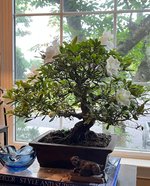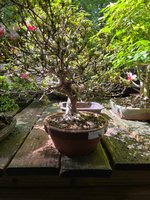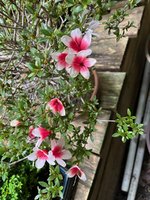Most def getting 50-150$ Cultivars. You’re right about learning to care for them first before going after the rare ones. Should be able to find some base on recommendation so far
For bonsai, cultivars don't determine the price. But of course the cultivar needs to be older than the bonsai itself.
For young plants/whips/training material/cuttings, new cultivars can be double the price. A new cultivar has to come from a single plant. And many enthusiasts may want to collect and try the newest hip cultivar. So demand will be larger than supply. But this is kinda how things in Japan are. In the US, you just but what you can find.
As someone who came into plants/gardening fresh with an interest in azalea and bonsai, it makes sense to first spend years on growing your species of interest and get the horticulture down.
Of course, if you are really serious about bonsai and starting out, you just try everything all at once, as long as you can afford it.
No one interested in say pine bonsai or maple bonsai is going to start an amateur pine or maple nursery, and produce a whole bunch of garden plants.
Then for satsuki another question is, do you nerd out on the satsuki cultivar? Or do you want to train and/or maintain a bonsai that just happens to be an azalea. Or both?
I do think that getting a couple of 5 to 8 year old satsuki bonsai imported from Japan would be good training. However, they can already get quite pricey.
Mr Shibue/SatsukiMania likely has a couple of these he can export to the US, besides the 1000+ USD bonsai listed on his webshop.
Getting a wired-up trunk where you can start by developing the foliage pads kind of from scratch would be good training.
I would say there is no reason to avoid rare/new cultivars. Those most popular for bonsai are 1) old, so plenty of old material out there 2) have good plant habit.
There is a plant habit focused vs flower-focused axis, where most new azaleas are more flower-focused. This is because it makes more sense to breed new varieties for their flowers rather than for their bonsai plant habit. However, there are also some more plant-habit modest-flowering new varieties out there.
I would say something that grows vigorously is ideal for beginners. Say, Korin.
I don't have 'Osakazuki' myself nor interested in getting it. If you planted 100,000 landscaping shrubs of 'Osakazuki' all across Japan back in 1920, then of course you see a lot of 'Osakazuki' bonsai today.
It is also kind of the most plain form of satsuki azalea, which means it is a really good selection considering plant habit and durability.
For younger plants, many people that can grow azaleas fine lack the growth season to see results with azaleas fast.
I have a plant I bought as a nursery plant more than 10 years ago. I am still growing it out in the ground. Now, it has about a thumb thick trunk.
In Japan, they seem to be able to get the same growth in about 8 years.
Now that I am growing many many seedlings, +3000-plus, there seems to be a thing about azaleas where they have some general health. If they are healthy, they grow and perform fine.
If they are not healthy, they can become healthy, but stay kind of stagnant for a few years, lacking vigorous growth.
And if they are in a sort of limbo between 'not healthy' and 'kind of healthy but stagnant', it is often not clear which direction they are moving.
Probably, most bonsai subjects are like this.









